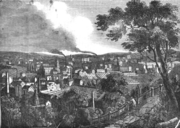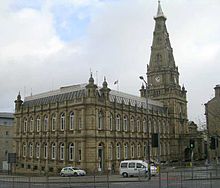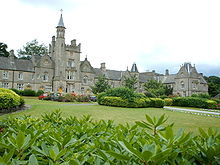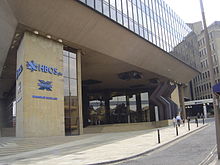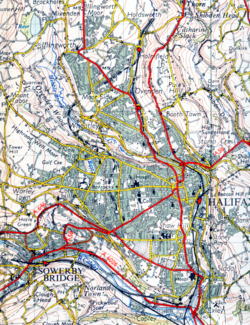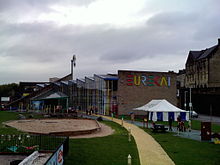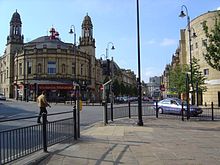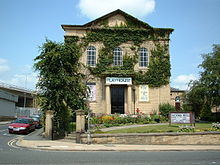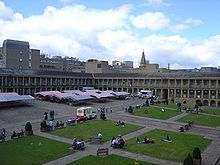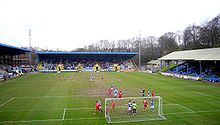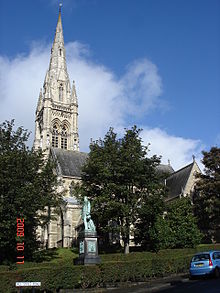- Halifax, West Yorkshire
-
For other uses, see Halifax.
Coordinates: 53°43′30″N 1°51′47″W / 53.725°N 1.863°W
Halifax 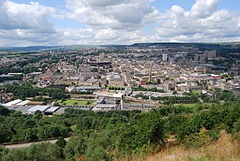
A view of Halifax from Beacon Hill
 Halifax shown within West Yorkshire
Halifax shown within West YorkshirePopulation 82,056 (2001 Census)[1] OS grid reference SE090254 Metropolitan borough Calderdale Metropolitan county West Yorkshire Region Yorkshire and the Humber Country England Sovereign state United Kingdom Post town HALIFAX Postcode district HX1-7 Dialling code 01422 Police West Yorkshire Fire West Yorkshire Ambulance Yorkshire EU Parliament Yorkshire and the Humber UK Parliament Halifax List of places: UK • England • Yorkshire Halifax is a minster town,[2][3] within the Metropolitan Borough of Calderdale in West Yorkshire, England. It has an urban area population of 82,056 in the 2001 Census.[1] It is well-known as a centre of England's woollen manufacture from the 15th century onward, originally dealing through the Halifax Piece Hall. Halifax is internationally famous for its Mackintosh chocolate and toffee (now owned by Nestlé), the Halifax Bank (formerly Halifax Building Society), and the nearby Shibden Hall.
Contents
History
The oldest written mentions of the town have the spelling as Haliflax, apparently meaning "holy flax" (Hair),[4] the second "l" having been subsequently lost by dissimilation. Local legend has it that the head of John the Baptist was buried here after his execution. The legend is almost certainly medieval rather than ancient, though the town's coat of arms still carries an image of the saint. An alternative explanation for the name of the town could come from a corruption of the Old English words Hay and Ley. Anecdotal evidence for this alternative and plausible explanation can be seen in the presence of Haley Hill, the nearby hamlet of Healey (another corruption). The fact that the surnames Hayley/Haley which are derived from Hay and Ley, for 'hay' and 'clearing' or 'meadow' respectively and are most abundant around the Halifax environs, also gives credibility for this explanation.[5]
The Earldom of Halifax took the name of the town. The first creation, in the Peerage of England in 1677, was for William Savile, 1st Viscount Halifax. He had already been made Baron Savile of Eland and Viscount Halifax in 1668 and was later made Marquess of Halifax (this creation of the earldom became extinct in 1700; see Marquess of Halifax for more information). George Montagu-Dunk, 2nd Earl of Halifax, (2nd order of the 3rd creation) became the President of the Board of Trade in 1748. In 1749 he helped to found the town (later city) of Halifax, the capital of Nova Scotia, Canada which was named after him. He helped foster trade, especially with North America. The Halifax River in Central Florida, United States, was named after him. Halifax Regional Municipality and Halifax County, in Canada, are also named in his honour.
Halifax Minster, parts of which go back to the 12th century, has always been dedicated to St John the Baptist. The Minster's first organist, in 1766, was William Herschel,[6] who went on to discover the planet Uranus. The coat of arms of Halifax include the chequers from the original coat of arms of the Earls Warenne, who held the town during Norman times.[7]
Halifax was notorious for the Halifax Gibbet, an early form of guillotine used to execute criminals by decapitation, last used in 1650. A replica of the gibbet has been erected on the original site in Gibbet Street. The original gibbet blade is on display at Bankfield Museum, Halifax. Punishment in Halifax was notoriously harsh, as remembered in the Beggar's Litany[8] by John Taylor (1580–1654), a prayer whose text included "From Hull, from Halifax, from Hell, ‘tis thus, From all these three, Good Lord deliver us.".[9]
The town's 19th-century wealth came from the cotton, wool and carpet industries and like most other Yorkshire towns had a large number of weaving mills many of which have been lost or converted to alternate use.
In November 1938, in an incident of mass hysteria, many in Halifax believed a serial killer—The Halifax Slasher—was on the loose. Scotland Yard was called in, but they concluded there were no "Slasher" attacks after several locals came forward and admitted they had inflicted the wounds upon themselves.[10]
Halifax has given its name to a bank, Halifax plc which started as a building society in the town. Nowadays Halifax is a trading name of HBOS, as part of the Lloyds Banking Group. Halifax is a twin town with Aachen in Germany. The A58 has a stretch called Aachen Way, with a plaque on the town-bound side of the road.
Halifax has benefited from Single Regeneration Budget, European URBAN II and the Home Office’s Community Cohesion Fund money through Action Halifax who have a vision for "a prosperous, vibrant and safe centre where all sections of the community can access opportunities to enhance their quality of life."
Governance
Halifax was incorporated as a municipal borough in 1848 under the Municipal Corporations Act 1835, and with the passing of the Local Government Act 1888 became a County Borough in 1889. Since 1974, Halifax has been the administrative centre of the Metropolitan Borough of Calderdale, once a part of the now-former metropolitan county of West Yorkshire.
The Calderdale suburbs north of Halifax are noted for its local support of the far-right British National Party; the suburb of Mixenden became the first area in West Yorkshire to popularly vote in a BNP councillor.[citation needed]
Geography
Topographically, Halifax is located in the south-eastern corner of the moorland region called the South Pennines. Halifax is situated about 4 miles (6 km) from the M62 motorway close to Bradford, Huddersfield and Rochdale. The Tees-Exe line passes through the A641 road, which links nearby Brighouse with Bradford and Huddersfield, The town lies 65 miles (105 km) from Kingston upon Hull and Liverpool, and about 170 miles (270 km) from the cities of London, Edinburgh, Belfast, Dublin and Cardiff as the crow flies. The major waterway is the Hebble Brook. The River Calder into which the Hebble joins it at Salterhebble bypasses the town and nearby Huddersfield.
Demographics
As of 2004[update],[1] Calderdale had a population of 192,405, of which 82,500 live in the Halifax urban area. The main ethnic group in Halifax is White (87%), followed by Pakistani (10%). Over 90% of people aged 16–74 were employed, mostly full-time. 64% of residents had qualifications. Halifax is home to a large South Asian community mainly of British Pakistanis from the Kashmir region. The majority of the community lives in the west central Halifax region of the town, which was previously home to immigrant Irish communities who have since moved to the outer suburbs. The Illingworth / Mixenden areas, in contrast to west central Halifax's ethnic diversity, consists mostly of white, indigenous Protestant residents. In the 2001 census,[1] 5% stated they were Muslim, 16.3% of no religion, and 63.8% of Christian background. 12.8% did not disclose their religion. The population density of the Halifax urban area is 530/km2.
Economy
As well as the significance of the bank Halifax plc which, since 2008, is part of the Lloyds Banking Group, the town has strong associations with confectionery.
John Mackintosh and his wife, Violet, opened a toffee shop in King Cross Lane in 1890. Violet formulated the toffee's recipe. John became known as "The Toffee King". A factory was opened on Queens Road in 1898. A new factory at Albion Mill, at the current site near the railway station, opened in 1909. John died in 1920, and his son Harold not only continued the business but took it to the present size and range of confectionery it has today. Their famous brands, including Rolo, Toffee Crisp and Quality Street of chocolate and confectionery are not just popular in the UK, but around the world including the USA.
In 1969 John Mackintosh & Co Limited merged with the York-based Rowntree Limited to form Rowntree Mackintosh. This was, in turn, purchased by Nestlé in 1988.
Halifax was a busy industrial town, dealing in and producing wool, carpets, machine tools, and beer. The Crossley family began carpet manufacture in modest premises at Dean Clough, on the banks of the Hebble Brook. The family was philanthropic and Joseph and Sir Francis Crossley built and endowed almshouses for their workers, which exist to this day and are run by volunteer trustees.
Halifax is also home to Suma Wholefoods, which was established in 1975 and is the largest workers co-operative in the UK.
Transport
Public bus and train transportation in Halifax is managed and subsidised by the West Yorkshire Passenger Transport Executive. It was announced in January 2009 that Halifax was to have a direct rail link to London after a long campaign backed by many, including the local paper the Courier; the service began to run on 23 May 2010.[11]
Bus
Most of the bus services in Halifax operate from the town's bus station. Unlike many other bus stations, Halifax is noted for having much character, with many listed buildings being incorporated on the site. First Calderdale & Huddersfield operate most of the town's services, while Centrebus Holdings operate many of the south Calderdale services.[12] Arriva Yorkshire operate services that link Halifax with the West Yorkshire towns and cities of Dewsbury and Wakefield. First operate bus services from Halifax to the town of Huddersfield and the nearby cities of Bradford and Leeds. First also run services into other counties, Rochdale in Greater Manchester and Burnley in Lancashire. Other bus operators in the town include T.J. Walsh (also known as The Halifax Bus Company) and Halifax Joint Committee which use the livery of the old Halifax Corporation buses, used on the town's buses until 1974.
Rail
Halifax railway station is on the Caldervale Line, with services to Manchester Victoria, York, Selby via Bradford and Leeds; Blackpool North; via Brighouse to Huddersfield and Wakefield Westgate and to London Kings Cross via Wakefield Kirkgate. All but the London service are operated by Northern Rail.
Rail passenger representation is organised by the local users' group, the Halifax and District Rail Action Group (HADRAG).[13]
The rail line leading from Halifax due north towards Keighley (and thus towards Skipton, Morecambe and Carlisle) with a further branch to Bradford via Queensbury saw its last through services in May 1955, although parts of the route, which was extremely heavily engineered with long tunnels and high, spectacular, viaducts, have now been repaired and revived by Sustrans as a walking and cycle route.
Media
Calderdale's local radio station, Phoenix Radio 96.7 FM has its studios in Halifax, and the Evening Courier, Calderdale's local newspaper, has its offices in the town.
Education
The Halifax area is home to two selective state schools, which are The Crossley Heath School, Savile Park[14] and North Halifax Grammar School in Illingworth[15]. Both schools achieve excellent GCSE and A-level results with both schools achieving a large proportion of A* to C grades at GCSE level. In 2005, the Crossley Heath School was the highest ranking co-educational school in the North of England.
The Crossley Heath School was formed when Heath Grammar School, an all boys' school given its charter by Elizabeth I of England, and The Crossley and Porter School, a mixed school founded with his brothers by Sir Francis Crossley, 1st Baronet which started as an orphanage, were combined in 1985. There are other schools in the area, including the Holy Trinity Church of England Senior School, which became an academy in 2010, and St Catherine's Catholic High School, both of which are located in Holmfield. In January 2006 Holy Trinity was designated a Specialist College for Business and Enterprise, whilst St Catherine's, was designated a Specialist Technology College.
Calderdale College is the local further education college on Francis Street, just off King Cross Road, in the west of the town. In December 2006 it was announced that Calderdale College, in partnership with Leeds Metropolitan University, opened a new higher education institution in January 2007 called 'University Centre Calderdale'.[16]
Culture
The 3rd Battalion Yorkshire Regiment (Duke of Wellington's) formerly the Duke of Wellington's Regiment (West Riding) Halifax Area Headquarters is based at Wellesley Park, on the junction of Gibbet Street and Spring Hall Road, in the former Wellesley Barracks Museum and Education Centre building. The Regimental Museum has been re-located within the Bankfield House Textile Museum on Haley Hill. The former barracks was converted into an educational school in 2005.
Former regimental colours of the 'Duke's' are laid up in the Halifax Minster. These include the stand used by the 33rd Regiment between 1761 and 1771, which is one of the oldest in existence in England, plus those carried by the regiment during the Battle of Waterloo and the Crimea.[17] The 1981 stand of colours, was taken out of service in 2002. They were marched through the town from the town hall to the Minster, which at that time was still a Parish Church, accompanied by two escorts of 40 troops, the Regimental Drums and the Heavy Cavalry and Cambrai Band on Sunday 31 March 2007. The troops were then inspected by The Lord Lieutenant of West Yorkshire, Dr Ingrid Roscoe BA, PhD, FSA and the Mayor of Halifax Cllr Colin Stout making a total of eight stands of colours within the Regimental Chapel. The regiment was presented with the "Freedom of Halifax" on 18 June 1945.
Eureka! The Museum for Children was inspired and opened by Prince Charles in the summer of 1992 and is located in part of the railway station. Once the home of the diarist Anne Lister, Shibden Hall is located just outside Halifax in the neighbouring Shibden Valley. Dean Clough, a refurbished worsted spinning mill, is the home of Barrie Rutter's Northern Broadsides Theatre Company and the IOU theatre company as well as providing space for eight art galleries.
Halifax, and in particular the Victoria Theatre (originally the Victoria Hall) is home to the oldest continually running amateur choral society in the country and possibly the world. Halifax Choral Society was founded in 1817 and has an unbroken record of performances. The Choral Society has a strong rivalry with the equally eminent nearby Huddersfield Choral Society. The Victoria Theatre contains a large concert organ built by William Hill & Sons that was installed in 1901. During the 1960s, when the hall was converted into the theatre, The organ was re-located to the back of the stage. The original console was replaced with a Rushworth and Dreaper unit, which consists of three manuals and a 32 note pedal board. A complete rewiring of the organ to add a second touch facility and a hydraulic lift was done, so it could be lowered and stored under the stage. The organ was rarely used, being played for a few orchestras and the choral society's Messiah. But the instrument is still playable and is occasionally used for private practice.
There is plenty to occupy lovers of amateur theatre. Halifax Thespians and the Actors' Workshop present plays of all kinds, and musical theatre is represented by Halifax Amateur Operatic Society, Halifax Light Opera Society, Halifax Gilbert and Sullivan Society, and All Souls Amateur Operatic Society. Halifax YMCA Pantomime Society presents its annual show in late January each year. Young people interested in drama are catered for by Halifax AOS and Halifax LOS, which each have a junior section, and another group, Stagedoor Theatre Co, specialises in dramatic activities and performances by children and young people. The Halifax & District Organists' Association, is one of the oldest organists' fellowships in the country.
As well as conventional cultural attractions, the Calderdale area has also become a centre for folk and traditional music. The Traditions Festival, held at the Halifax Piece Hall in the town centre, is a celebration of traditional music and dance from around the world, whilst the Rushbearing, held in Sowerby Bridge and the surrounding villages, is a traditional festival which was restarted to celebrate the Queen's Silver Jubilee and attracts Morris dancers from all around the country. The Square Chapel Centre for the Arts offers music, dance, plays, comedy as well as community events such as tea dances. The Victoria Theatre seats 1,568 people or 1,860 for a standing concert, and hosts a variety of performances.
Halifax town centre has a busy night life with lots of clubs and bars. To help with those who become vulnerable whilst enjoying and using Halifax's night life, Street Angels was launched in November 2005. Street Angels patrol the town centre on Fridays and Saturdays between 9 p.m. and 3 a.m.. In the first year police report violent crime has fallen by 42%. Street Angels work in partnership with St. John Ambulance, Nightlife Marshals, Police Community Support Officers, Police and door-staff as well as the Halifax Ambassadors who patrol in the daytime.
Halifax had one of the highest densities of pubs to inhabitants during a study that took place in the late 1990s.[citation needed] One such establishment that gained notoriety during November 2005 was the Zoo Bar. The nightclub had a history of under-age drinking, and became the first establishment in the UK to be closed because of the Licensing Act 2003. At the time of the police intervention officers reportedly identified 420 of the 500 people in the club to be under-age drinkers. The nightclub was identified in an American study regarding youths and alcohol and gained European notoriety. The nightclub was subsequently closed and sold to developers to renovate into flats. A recent report showed Halifax to have above average levels of drink-related violence and associated issues.
Landmarks
- The Piece Hall is the former cloth hall, where the trading of woollen cloth pieces was done. Opened on 1 January 1779, it was only open for business for two hours on a Saturday morning and contained 315 merchant trading rooms. After the mechanisation of the cloth industry, the Piece Hall became a public market. The former Calderdale Industrial Museum (now closed) was located beside the Piece Hall.
- Dean Clough Mill located beside the Victorian Gothic Revival North Bridge was built in the 1840s–60s for Crossley's Carpets, owned by John Crossley and was once the largest carpet factory in the world. It is now a thriving business park after being converted in the 1980s.
- Halifax Town Hall was designed by Charles Barry, who also designed the Houses of Parliament, in 1863.
- Borough Market is an award winning Victorian covered market place in the town centre.
- The Wainhouse Tower, at King Cross, is a late Victorian folly constructed between 1871 - 1875. Originally intended to be the chimney for a dye works, it became a folly after the dye works was sold in 1874 and the new owner refused to pay for its completion. It is the tallest folly in the world and the tallest structure in Calderdale.[18][19]
Sport
The town has relatively successful sport clubs. Its rugby league club, Halifax RLFC, plays in Co-operative Championship. The town's football team, F.C. Halifax Town formed from the ashes of Halifax Town A.F.C. after the club was liquidated while in the Football Conference. They reformed three leagues below and now currently play in the Blue Square Conference North division.
Halifax is one of the most historic rugby league clubs in the game, formed over a century ago, in 1873 in the Yorkshire town of Halifax. Known as 'Fax', the official club colours are blue and white hoops, hence the former 1990s nickname: The Blue Sox. Halifax are also one of the original twenty-two rugby clubs that formed the Northern Rugby Football Union in 1895, making them one of the world's first rugby league clubs. They have rivalries with local neighbours Bradford and Huddersfield. Halifax have won the Rugby Football League Championship on four occasions: in 1902–03, 1906–07, 1964–65, 1985–86 and the Challenge Cup five times: in 1903, 1904, 1931, 1939 and 1987. They won the Co-operative Championship Grand Final in 2010. Halifax played at the Thrum Hall ground from 1886 to 1998. The ground staged rugby for 112 years and closed its gates for the last time after Halifax had won what was misleadingly billed as a friendly against Leeds 35–28.[20]
Since then both teams share the Shay football ground, which is the largest ground used by a non-league football club in England. In the 1960s Halifax Town played Millwall in a Fourth Division match that had the lowest attendance ever recorded for a professional match in England. The Crossley Heath Grammar School normally excels in nationwide school rugby union competitions.[21][22][23]
Motorcycle speedway racing has been staged at two venues in Halifax. In the pioneering days of 1928–1930 a track operated at Thrum Hall. A Halifax team took part in the English Dirt Track League of 1929. Speedway returned to Halifax at the Shay Stadium in 1949 and operated until 1951. The team operated as the Halifax Nomads in 1948 racing three away fixtures. The Halifax Dukes, the name they took once the Shay was opened, operated in the National League Third Division in 1949 before moving up to the Second Division in 1950. Riders including Arthur Forrest, moved on to Bradford. The Dukes re-emerged in 1965 as founder members of the British League and operated there for many years before the team moved en bloc to Odsal Stadium, Bradford. The steeply banked bends of the track at the Shay have been buried under stands at either end when the spectator facilities were squared off.
Religious buildings
The 15th century Minster dedicated to St. John the Baptist did not achieve cathedral status when a new diocese was being considered for the West Riding (Wakefield Parish Church became the cathedral in 1888 and was extensively altered and enlarged). Minster Status was conferred on the Parish Church in a ceremony on 22 November 2009.[2] There is a collection of rare Commonwealth white glass as well as a series of Victorian windows. Another feature is the complete array of Jacobean box pews. The pair of Gothic organ cases by John Oldrid Scott now house the four-manual instrument by Harrison & Harrison. The belfry holds fourteen bells and an Angelus.
The Serbian Orthodox Church dedicated to St. John the Baptist, in the Boothtown area, formerly the Mount Carmel Methodist Chapel, was acquired in 1956 and after extensive refurbishment was opened in the early part of the 1960s by the towns Serbian community.[24]
The currently mothballed mid-Victorian All Souls Church by Sir George Gilbert Scott standing part way up Haley Hill to the north of the main town centre is now vested in the Historic Churches Preservation Trust. Its lofty 236-foot (72 m) spire and white magnesian limestone exterior stand as a very personal statement in 13th century French style of the mill owner Colonel Edward Akroyd, who paid solely for its construction as the centre-piece of a purpose-built model village ("Akroydon"). All Souls' boasts an unusually complete sequence of windows by the leading artists of the 1850s, including William Wailes, John Hardman and Clayton & Bell. The large organ by Forster & Andrews inserted in 1868, ten years after the building was completed, is currently unplayable and many of its surviving parts are in storage awaiting restoration. The tower houses a ring of eight bells.
Other churches include the Georgian Holy Trinity Church (now converted to office use) and the late neo-Gothic (1911) St. Paul's, King Cross, by Sir Charles Nicholson. St Paul's is notable not only for its fine acoustics but also for an unusual and highly colourful west window, specified by Nicholson, showing the apocalyptic vision of the Holy City descending upon the smoky mills and railway viaducts of Halifax as it was before the First World War.[25]
The spire of the Square Church, not far from the Minster at the bottom of the town, paid for by the carpet manufacturing Crossley family, is all that remains of the Gothic Congregational church built by Joseph James in 1856–58 as a rival design to All Souls', Haley Hill. The building was closed in 1969 and arsonists caused severe damage to the building two years later leading to its partial demolition. The rather comic story of the rival spires runs that the two buildings' towers were nearing completion simultaneously; the architects were ordered to stop work within a few feet of the top of the spires to see who would finish first. After some time, the Crossleys lost patience and finished their spire at 235-foot (72 m), prompting the immediate completion of the rival building one foot higher. The neighbouring and earlier (Georgian) Square Chapel (1772) survived a hundred years of use as a church hall and Sunday School for the larger church: it is currently an arts centre.
There are four Mosques in Halifax, the main ones being Madni Jamia Mosque on Gibbet Street, and Al Jamia Al Zahra which is co-located with: Zahra Educational and Cultural Centre, on Francis Street. Syed Ahmad Hussain Shah Tirmezi is head Imam of this Mosque.
Notable Haligonians
- Tom Bailey, singer with the Thompson Twins
- Phyllis Bentley, novelist
- Henry Briggs, mathematician
- John Reginald Halliday Christie, the murderer from 10 Rillington Place
- Keith Clifford, actor, in Last of the Summer Wine & Coronation Street
- Shirley Crabtree, wrestler Known as 'Big Daddy'
- George Dyson, composer
- Tony Field, footballer
- Stuart Fielden, rugby league footballer
- David Hartley, philosopher
- Charles Horner, jeweller and inventor of the Dorcas thimble
- Nick Holmes, singer of the band Paradise Lost
- Barrie Ingham, actor
- Paddy Kenny, footballer
- John Kettley, weatherman
- Nick Lawrence, radio presenter
- Anne Lister, diarist and former owner of Shibden Hall
- John Mackintosh, created Mackintosh's Toffee, which became Rowntree Mackintosh
- Harold Vincent Mackintosh 1st Viscount Mackintosh of Halifax & chocolate manufacturer
- Thomas Milner, actor
- Brian Moore, rugby union footballer, TV Presenter, Pundit and Journalist
- Thomas Nettleton, local physician who carried out some of the earliest systematic programs of smallpox vaccination
- John Noakes, TV presenter
- John Pawson, architect
- Carolyn Pickles, actress
- James Pickles, judge
- Wilfred Pickles, actor, comedian & broadcaster
- Kathryn Pogson, actress
- Eric Portman, actor
- Jesse Ramsden, inventor of the Ramsden theodolite
- Sir Richard Saltonstall, colonist
- Sir Henry Savile, bible translator
- Percy Shaw, inventor of Cat's Eyes, used on public roads
- Ed Sheeran, Singer/songwriter
- Robin Simon, guitarist
- Herbert Akroyd Stuart, inventor of the Hot Bulb Engine (ancestor to the diesel engine)
- John Tillotson, Archbishop of Canterbury (1691–1694)
- Brian Turner, chef, restaurateur and TV personality
- Séan Walsh, local poet, writer & artist
- Emma Williams (actress), West End musical theatre actress
- John Wolfenden, Baron Wolfenden, chairman of the Wolfenden committee
- Matthew Wolfenden (actor), actor in ITV's Emmerdale
- Patrick Woodroffe, science fiction and fantasy artist
- Frank Worthington, footballer
See also
- Halifax College, a college of the University of York
- Handley Page Halifax
- HMS Halifax
- Walterclough Hall
References
- ^ a b c d "2004 Calderdale Ward Digest - Census 2001 (August 2004)" (PDF). Calderdale Council. August 2004. http://www.calderdale.gov.uk/council/statistics/ward-information/warddigest/digest.pdf. Retrieved 2008-10-11.
- ^ a b Halifax Courier - We're a Minster town!, Published Date: 23 November 2009
- ^ Halifax Courier - Halifax Minster: the start of a new era. Published Date 24 November 2009
- ^ Google Books - A dictionary of the Anglo-Saxon language, by Joseph Bosworth (1838) - Page 112
- ^ Eilert Ekwall (1936). The Concise Oxford Dictionary of English Place-Names (Fourth edition 1960 ed.).
- ^ National Pipe Organ Register
- ^ Arms of Halifax, Civic Heraldry of England and Wales, civicheraldry.co.uk
- ^ Yorkshire History - Halifax Gibbet
- ^ The association of these three names pre-dates Taylor however, for the poet Thomas Nashe refers to them: "...neither in Hull, Hell, nor Halifax." - Nashes Lenten Stuffe, London, 1599.
- ^ BBC.co.uk Radio 4 History - The Halifax Slasher
- ^ Halifax Courier London rail link: (30 January 2009)
- ^ "Centrebus services south Calderdale". wymetro.com. http://wymetro.com/news/releases/archive/09/091105ruralsouthcalderdale. Retrieved 2010-09-26.
- ^ Halifax Courier Article Halifax and District Rail Action Group
- ^ "League Tables: The Crossley Heath School". BBC News. 2007-01-11. http://news.bbc.co.uk/1/shared/bsp/hi/education/06/school_tables/secondary_schools/html/381_5401.stm. Retrieved 2007-05-16.
- ^ "League Tables: The North Halifax Grammar School". BBC News. 2007-01-11. http://news.bbc.co.uk/1/shared/bsp/hi/education/06/school_tables/secondary_schools/html/381_5400.stm. Retrieved 2007-05-16.
- ^ Leeds Metropolitan University Website: University Centre Calderdale launched
- ^ The Duke of Wellington's Regiment (West Riding) - A Short History, by Major Savoury MBE & Major General DE Isles, CB OBE DL
- ^ [http://www.icons.org.uk/nom/nominations/wainhouse "Wainhouse Tower, Halifax - Icons of England"]. http://www.icons.org.uk/nom/nominations/wainhouse. Retrieved 2011-03-25.
- ^ "Introduction: Wainhouse Tower: Calderdale Council". http://www.calderdale.gov.uk/leisure/localhistory/wainhouse-tower/index.html. Retrieved 2011-03-25.
- ^ Hadfield, Dave (1998-03-23). "Rugby League: Thrum Hall tradition ends after112 years". The Independent (London). http://www.independent.co.uk/sport/rugby-league-thrum-hall-tradition-ends-after112-years-1151908.html.
- ^ "Crossley Heath upset Warwick". London: Daily Mail. 2005-02-09. http://www.dailymail.co.uk/sport/rugbyunion/article-337198/Crossley-Heath-upset-Warwick.html. Retrieved 2008-10-11.
- ^ "In Focus: Crossley Heath". London: Daily Mail. 2005-02-23. http://www.dailymail.co.uk/sport/rugbyunion/article-338972/In-Focus-Crossley-Heath.html. Retrieved 2008-10-11.
- ^ Jim Hooley (2005-04-25). "Channing chips in". London: Daily Mail. http://www.dailymail.co.uk/sport/rugbyunion/article-342593/Channing-chips-in.html. Retrieved 2008-10-11.
- ^ St. John the Baptist Church history
- ^ "St Paul's, King Cross". http://www.stpaulskingcross.co.uk/index.html. Retrieved 2011-03-25.
External links
- Street Angels Halifax
- Action Halifax Regeneration Partnership
- Phoenix Radio 96.7 FM
- Halifax Rugby League Football Club
- Halifax Town Online
- Halifax Courier
- Tourist Information
Arts
- Dean Clough - Arts, business, education and design complex
- Square Chapel Centre for the Arts
- Northern Broadsides Theatre Company
- Halifax Gilbert & Sullivan Society
Museums
Ceremonial county of West Yorkshire Yorkshire Portal Metropolitan districts Major settlements Batley • Bingley • Bradford • Brighouse • Castleford • Cleckheaton • Denholme • Dewsbury • Elland • Farsley • Featherstone • Garforth • Guiseley • Halifax • Hebden Bridge • Hebden Royd • Heckmondwike • Hemsworth • Holmfirth • Horsforth • Huddersfield • Ilkley • Keighley • Knottingley • Leeds • Meltham • Mirfield • Morley • Mytholmroyd • Normanton • Ossett • Otley • Pontefract • Pudsey • Rothwell • Shipley • Silsden • South Elmsall • Sowerby Bridge • Todmorden • Wakefield • Warley Town • Wetherby • Yeadon
See also: List of civil parishes in West YorkshireTopics Parliamentary constituencies • West Yorkshire Joint Services • Monastic houses • Museums • WindmillsCategories:- Halifax, West Yorkshire
- Market towns in West Yorkshire
- Geography of Calderdale
- Towns in West Yorkshire
Wikimedia Foundation. 2010.




